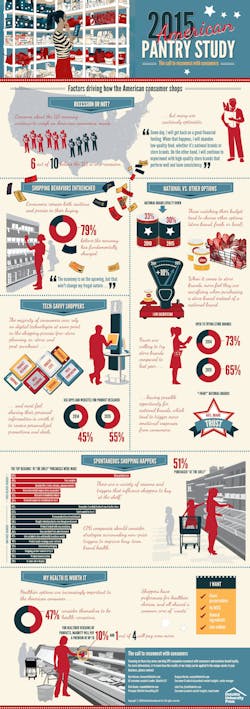Deloitte Survey: Shoppers Continue To Leave National Brands Behind
NEW YORK, June 23, 2015 /PRNewswire/ -- America's national food, beverage and household brands struggle to regain favor in the hearts and minds of U.S. consumers for the fifth year in a row, according to Deloitte's annual American Pantry Study of more than 354 brands across 34 product categories.
Nearly 3 in 4 (73 percent) consumer packaged goods (CPG) categories show an overall decline in their brands' "must-have" status, meaning that shoppers would purchase whether on sale or not. However, this year's study also showed a drop in store brands' appeal, improved consumer perceptions of the economy, and shoppers' willingness to pay a premium for attributes such as health and convenience – which may signal a turning point that is set to further disrupt the CPG industry after years of consumer caution.
"This is a critical moment for consumer product companies," said Barb Renner, vice chairman, Deloitte LLP and U.S. Consumer Products leader. "While the majority of consumers say they are committed to sustained frugality year after year, our findings point to early signs that they may finally be responding to a belated but increasingly strong economic recovery. It creates tremendous opportunities and risks for companies in this sector, given households' lack of commitment to national brands brought on by years of stretching dollars to the limit. Brands that get things right can use the economy's momentum to regain their place on consumers' shelves, but those that move too slowly could very well be left behind."
While previous years of economic stagnation fueled consumers' interest in store brands, this year's study revealed that trend may be reversing as recession-weary consumers loosen their purse strings. The number of consumers who view store brands as a sacrifice (43 percent) jumped 10 percentage points, while fewer consumers (65 percent) indicate they are more open to trying store branded products, an eight percentage point decline.
Moreover, roughly one-quarter (25 percent) of consumers indicate they are willing to pay 10 percent or more for a product that is new or innovative, and one-third (33 percent) will do so for a craft version of food or beverages.
Digital paves the "path to purchase"
According to the study, more than half (55 percent) of consumers turn to digital tools to research products, up from 45 percent last year, and ahead of the number who do so to compare prices (48 percent), which remained flat compared with last year. Additionally, 4 in 10 (37 percent) use devices to make shopping lists or meal plans. These behaviors signal multiple points to interact with people along the path to purchase outside of traditional discounts, from building today's list to planning next week's dinner.
Consumer packaged goods companies should note that when it comes to online orders and delivery, there is a noticeable gap between consumers' interest levels and current activity. For example, 38 percent of consumers are interested in online grocery orders for in-store pick up, but only 11 percent already use this service. Similarly, 27 percent are interested in home delivery orders placed online for recurring purchases, but only 11 percent already use such a service. The study suggests there may be a shortage of services consumers seek, creating significant unmet demand that CPG companies can pursue for growth.
Winning at the shelf: Price is just one tool
Understanding the drivers of at-the-shelf purchases can help brands improve their promotional strategies and better connect with consumers, according to Deloitte's study.
Roughly half (51 percent) of consumers make purchase decisions at the shelf, and while discounts and promotions are important, they are not the only deciding factor. When asked what triggers an impulse buy, 89 percent of shoppers cite discounted prices, but many also indicate that they bought an item because they remembered it when they spotted it in the store (81 percent), and nearly two-thirds (63 percent) say they did so because they wanted to try a new product.
"Although price remains the single biggest factor influencing at-the-shelf purchases, many other aspects can also catch shoppers' attention," said Rich Nanda, principal, Deloitte Consulting LLP and co-author of the study. "CPG companies should step back and consider challenging the status quo, rather than immediately resorting to discounts and promotions. Focusing more effort on non-price related triggers might seem risky in the short-term, but may improve long-term brand health, loyalty and margins."
Health and wellness attributes also rank high on consumers' shopping lists. Nearly 9 in 10 consumers (86 percent) prefer convenient options that are also healthy, and 25 percent are willing to pay a 10 percent premium or more for healthier versions of a product. Further, 41 percent chose the product at the shelf because the label addressed their health and wellness concerns.
For more information about the 2015 American Pantry Study, including in-depth survey findings, please visit: http://www.deloitte.com/us/AmericanPantry15. Follow at @DeloitteCB on Twitter, #AmericanPantry15.
